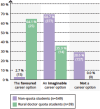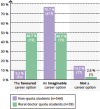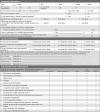Rural doctor quota students in Germany - who are they? Data on first year students from two cohorts in the federal state of Saxony
- PMID: 40329552
- PMCID: PMC12064117
- DOI: 10.1080/10872981.2025.2497325
Rural doctor quota students in Germany - who are they? Data on first year students from two cohorts in the federal state of Saxony
Abstract
The lack of physicians in rural areas is a universal problem. To increase the attractiveness of rural practice for medical students, the contribution of medical schools is undisputed. However, much of the evidence on interventions before and during undergraduate education comes from countries with large areas and low population density like Australia and Canada. In Germany, selective admission to medical studies for students who agree to become rural general practitioners is still a new concept. The aim of this study was to assess the sociodemographic characteristics, attitudes and career aspirations of the rural doctor quota students from one medical school in Germany compared to their non-quota counterparts. For this cross-sectional study, a paper-based anonymous questionnaire was distributed to all first year medical students at Leipzig University in two consecutive study years.Descriptive analyses and group differences were calculated using SPSS. The response rate was 87.3% with n = 604 completed questionnaires and 40 (6.6%) students self-classified as rural doctor quota students. Quota students grew up in rural areas significantly more often than their counterparts and had more working experience in the medical field. General practice was the preferred career option for 64.1% (25/39, versus 2.7% [15/549] of non-quota students). Working self-employed in one's own medical practice was the preferred option for 71.1% (27/38) of quota students (vs. 28.0% [153/546] of non-quota students). Quota students valued a broad spectrum of patients, a long-term doctor-patient relationship, employee management and prestige more highly than their fellow students. Students from the rural doctor quota largely exhibit characteristics and attitudes that are compatible with future rural practice, despite showing little differences in sociodemographic items such as age and marital status. Not all students agree with the program objective. To demonstrate an impact on the health services, longitudinal data is necessary to monitor career choices over time.
Keywords: Undergraduate medical education; general practice; medical students; public health; rural health services.
Conflict of interest statement
No potential conflict of interest was reported by the author(s).
Figures






Similar articles
-
On the attractiveness of working as a GP and rural doctor including admission pathways to medical school - results of a German nationwide online survey among medical students in their "Practical Year".GMS J Med Educ. 2021 Sep 15;38(6):Doc102. doi: 10.3205/zma001498. eCollection 2021. GMS J Med Educ. 2021. PMID: 34651060 Free PMC article.
-
Recruitment of doctors to work in 'our hinterland': first results from the Swansea Graduate Entry Programme in Medicine.Rural Remote Health. 2015 Jul-Sep;15(3):3187. Epub 2015 Sep 20. Rural Remote Health. 2015. PMID: 26387776
-
Career preferences of graduating medical students in China: a nationwide cross-sectional study.BMC Med Educ. 2016 May 6;16:136. doi: 10.1186/s12909-016-0658-5. BMC Med Educ. 2016. PMID: 27154313 Free PMC article.
-
Strengthening training in rural practice in Germany: new approach for undergraduate medical curriculum towards sustaining rural health care.Rural Remote Health. 2015;15(4):3563. Epub 2015 Nov 11. Rural Remote Health. 2015. PMID: 26564099 Review.
-
A review of characteristics and outcomes of Australia's undergraduate medical education rural immersion programs.Hum Resour Health. 2018 Jan 31;16(1):8. doi: 10.1186/s12960-018-0271-2. Hum Resour Health. 2018. PMID: 29386024 Free PMC article. Review.
References
MeSH terms
LinkOut - more resources
Full Text Sources
Medical
